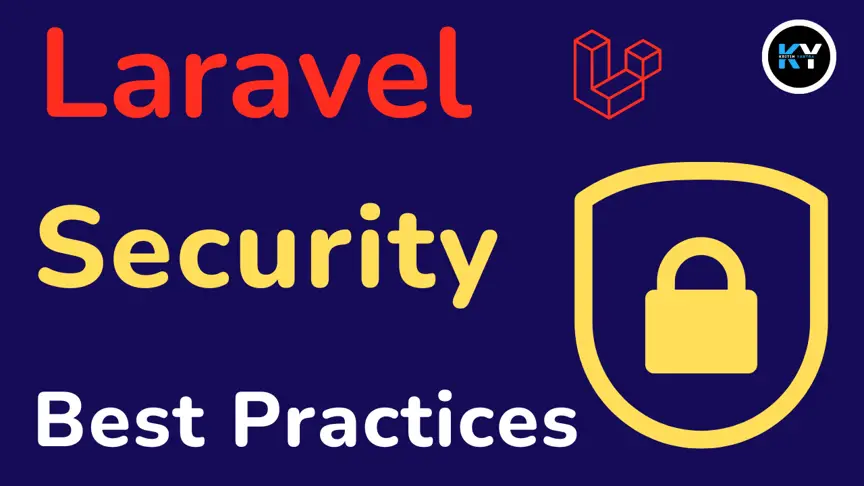Laravel 12 API Security Best Practices – A Beginner-Friendly Guide

Kritim Yantra
Mar 01, 2025
Welcome to this beginner-friendly, detailed guide on securing your Laravel 12 APIs! If you're new to Laravel or API development, don’t worry—I’ll explain everything in simple language, step by step. APIs (Application Programming Interfaces) are like messengers that let your app talk to other apps or services. But since they handle important data, keeping them secure is a big deal. In this blog, we’ll explore the best practices to protect your Laravel 12 APIs from common threats, making sure your app stays safe and trustworthy. Let’s dive in!
Why API Security Matters in Laravel 12
Imagine your API as a door to your house. If it’s not locked properly, anyone can walk in and take what’s inside. In the same way, an unsecured API can let hackers access sensitive information like user passwords or personal details. Laravel 12 is a powerful PHP framework that makes building APIs easy, and it comes with tools to help you secure them. But you still need to use these tools correctly. By following these best practices, you’ll keep your API safe and your users happy.
1. Set Up Your Laravel 12 Project
Before we talk security, let’s quickly set up a fresh Laravel 12 project. If you haven’t installed Laravel yet, you’ll need the Laravel installer. Open your terminal and run:
composer create-project laravel/laravel laravel-api-security
cd laravel-api-securityThis creates a new Laravel 12 project. Now, let’s make sure it’s running:
php artisan serveVisit http://localhost:8000 in your browser to confirm it’s working. Great! Now we’re ready to secure our API.
2. Use HTTPS for All API Requests
Think of HTTPS as a secure tunnel for your data. Without it, data travels in plain text, and hackers can easily read it. With HTTPS, everything is encrypted, keeping it safe. To make your Laravel 12 API use HTTPS:
- Get an SSL Certificate: If you’re testing locally, use a tool like Laravel Valet or a free certificate from Let’s Encrypt. For production, your hosting provider (like DigitalOcean or AWS) can help you set this up.
- Force HTTPS in Laravel: Open
app/Providers/AppServiceProvider.phpand add this code in thebootmethod:
public function boot()
{
if (env('APP_ENV') === 'production') {
URL::forceScheme('https');
}
}This ensures all API requests use HTTPS in production. Simple, right?
3. Protect Sensitive Data with Environment Variables
Your API might need secrets like database passwords or API keys. Never write these directly in your code—hackers could find them! Instead, use the .env file in your Laravel project. For example:
DB_PASSWORD=mysecretpassword
API_KEY=xyz123To use these in your app, access them like this in your code:
$apiKey = env('API_KEY');Make sure .env is never uploaded to public places like GitHub. Laravel ignores it by default (check .gitignore), so you’re safe as long as you don’t change that.
4. Authenticate Users with Laravel Sanctum
APIs need to know who’s making requests. Laravel Sanctum is a simple tool to secure your API with tokens. Let’s set it up:
- Install Sanctum: Run this in your terminal:
composer require laravel/sanctum
php artisan vendor:publish --provider="Laravel\Sanctum\SanctumServiceProvider"
php artisan migrate- Add Sanctum Middleware: Open
app/Http/Kernel.phpand add this to theapimiddleware group:
'api' => [
\Laravel\Sanctum\Http\Middleware\EnsureFrontendRequestsAreStateful::class,
'throttle:api',
\Illuminate\Routing\Middleware\SubstituteBindings::class,
],- Protect Routes: In
routes/api.php, add authentication to your routes:
use App\Http\Controllers\ApiController;
Route::middleware('auth:sanctum')->get('/user', [ApiController::class, 'getUser']);Issue Tokens: When a user logs in, give them a token. Create a controller (ApiController.php) like this:
namespace App\Http\Controllers;
use Illuminate\Http\Request;
use App\Models\User;
class ApiController extends Controller
{
public function login(Request $request)
{
$credentials = $request->only('email', 'password');
if (auth()->attempt($credentials)) {
$user = auth()->user();
$token = $user->createToken('MyApp')->plainTextToken;
return response()->json(['token' => $token]);
}
return response()->json(['error' => 'Unauthorized'], 401);
}
public function getUser(Request $request)
{
return $request->user();
}
}Now, users can log in and get a token. They’ll send this token with every request in the Authorization header like this: Bearer xyz123.
5. Validate and Sanitize User Input
Hackers often try to send bad data to trick your API (like SQL injection or XSS attacks). Laravel makes it easy to stop this by validating input. For example, let’s create a route to save a blog post:
Route::post('/posts', [ApiController::class, 'store'])->middleware('auth:sanctum');In your ApiController.php:
public function store(Request $request)
{
$validated = $request->validate([
'title' => 'required|string|max:255',
'content' => 'required|string',
]);
// Save the post (example)
return response()->json(['message' => 'Post created', 'data' => $validated], 201);
}Here, validate checks that title and content are safe. If they’re not, Laravel sends an error response automatically. This keeps your API safe from junk data.
6. Prevent SQL Injection with Eloquent
SQL injection is when hackers sneak bad code into your database queries. Laravel’s Eloquent ORM stops this by using safe methods. For example, instead of writing raw SQL like:
DB::select("SELECT * FROM posts WHERE id = $id"); // Dangerous!Use Eloquent:
use App\Models\Post;
$post = Post::find($id);Eloquent escapes the input for you, so hackers can’t mess with your database. Stick to Eloquent or the Query Builder, and you’re golden.
7. Limit Requests with Rate Limiting
What if someone spams your API with tons of requests? That could crash your app! Laravel’s rate limiting stops this. In routes/api.php, the throttle middleware is already included:
Route::middleware('auth:sanctum', 'throttle:60,1')->group(function () {
Route::get('/posts', [ApiController::class, 'index']);
});This limits users to 60 requests per minute. If they go over, they’ll get a “Too Many Requests” error (HTTP 429). Adjust the numbers (e.g., 100,1 for 100 requests per minute) based on your needs.
8. Disable Debug Mode in Production
Debug mode is great for development—it shows errors with details. But in production, it can leak sensitive info like database passwords. Open your .env file and set:
APP_DEBUG=false
APP_ENV=productionNow, errors won’t show sensitive details. Test this locally by setting APP_DEBUG=false and visiting a broken route—you’ll see a plain error page.
9. Use Middleware for Extra Security
Middleware is like a gatekeeper for your routes. You can create custom middleware to check things before a request reaches your API. Let’s make one to log requests:
php artisan make:middleware LogRequestsOpen app/Http/Middleware/LogRequests.php:
namespace App\Http\Middleware;
use Closure;
use Illuminate\Support\Facades\Log;
class LogRequests
{
public function handle($request, Closure $next)
{
Log::info('API Request', [
'method' => $request->method(),
'url' => $request->url(),
'user' => $request->user() ? $request->user()->id : 'guest',
]);
return $next($request);
}
}Register it in bootstrap/app.php:
->withMiddleware(function (Middleware $middleware) {
$middleware->api(append: [\App\Http\Middleware\LogRequests::class]);
})
];Now, every API request is logged. You can check logs in storage/logs/laravel.log. This helps you spot weird activity.
10. Keep Laravel Updated
Laravel fixes security bugs with updates. To check for updates, run:
composer outdatedTo update Laravel and its packages:
composer updateTest your app after updating to make sure nothing breaks. Staying current keeps your API safe from known issues.
Bonus Tips for Beginners
- Backup Your Database: Use a package like
spatie/laravel-backupto save your data regularly. - Test Your API: Use tools like Postman to try your API and make sure it’s secure.
- Learn More: Check Laravel’s official docs (
laravel.com) for deeper details.
Wrapping Up
Securing your Laravel 12 API doesn’t have to be hard! With HTTPS, Sanctum for authentication, input validation, rate limiting, and a few other tricks, you’ve got a solid foundation. Think of these practices as locks on your API’s doors—each one makes it tougher for hackers to get in. Start small, test as you go, and soon you’ll have a safe, reliable API. Happy coding, and stay secure!
Comments
No comments yet. Be the first to comment!
Please log in to post a comment:
Sign in with GoogleRelated Posts

 Kritim Yantra
Kritim Yantra

